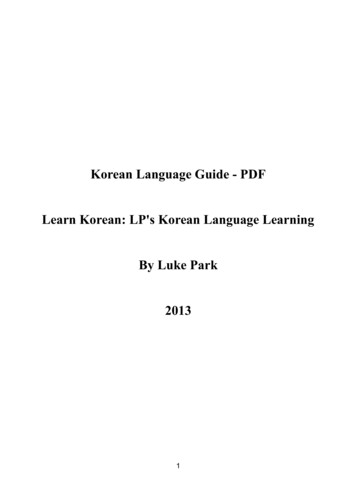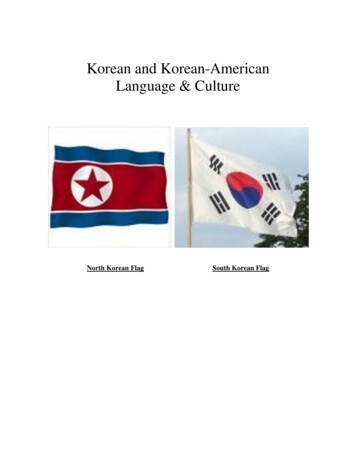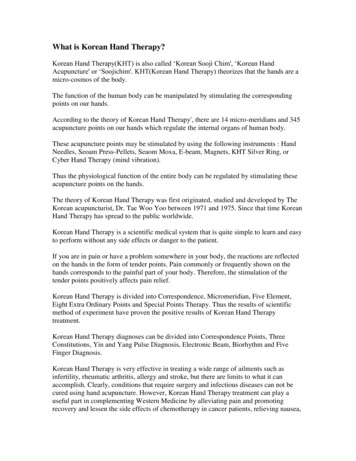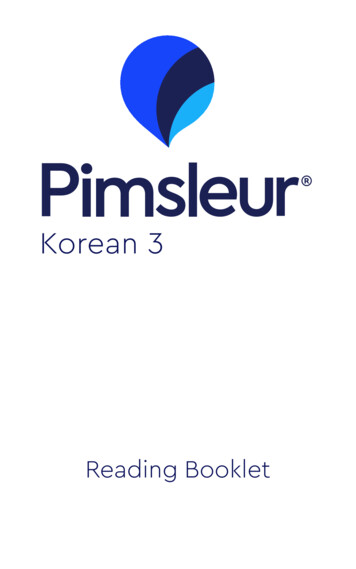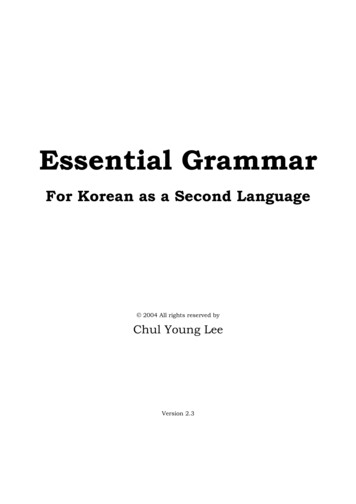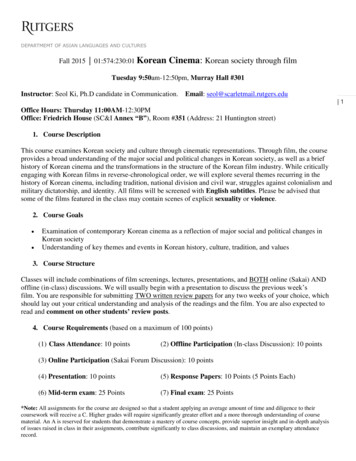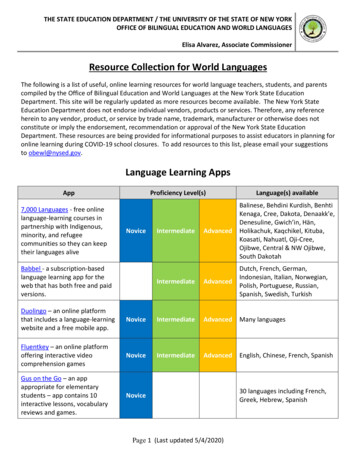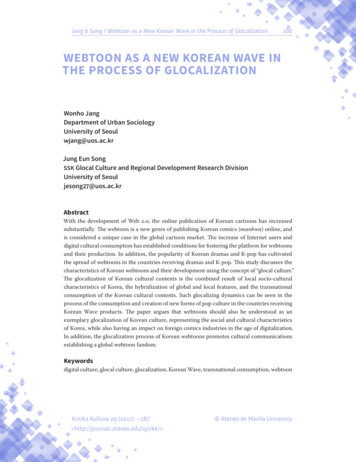
Transcription
Jang & Song / Webtoon as a New Korean Wave in the Process of Glocalization 168WEBTOON AS A NEW KOREAN WAVE INTHE PROCESS OF GLOCALIZATIONWonho JangDepartment of Urban SociologyUniversity of Seoulwjang@uos.ac.krJung Eun SongSSK Glocal Culture and Regional Development Research DivisionUniversity of Seouljesong27@uos.ac.krAbstractWith the development of Web 2.0, the online publication of Korean cartoons has increasedsubstantially. The webtoon is a new genre of publishing Korean comics (manhwa) online, andis considered a unique case in the global cartoon market. The increase of Internet users anddigital cultural consumption has established conditions for fostering the platform for webtoonsand their production. In addition, the popularity of Korean dramas and K-pop has cultivatedthe spread of webtoons in the countries receiving dramas and K-pop. This study discusses thecharacteristics of Korean webtoons and their development using the concept of “glocal culture.”The glocalization of Korean cultural contents is the combined result of local socio-culturalcharacteristics of Korea, the hybridization of global and local features, and the transnationalconsumption of the Korean cultural contents. Such glocalizing dynamics can be seen in theprocess of the consumption and creation of new forms of pop culture in the countries receivingKorean Wave products. The paper argues that webtoons should also be understood as anexemplary glocalization of Korean culture, representing the social and cultural characteristicsof Korea, while also having an impact on foreign comics industries in the age of digitalization.In addition, the glocalization process of Korean webtoons promotes cultural communicationsestablishing a global webtoon fandom.Keywordsdigital culture, glocal culture, glocalization, Korean Wave, transnational consumption, webtoonKritika Kultura 29 (2017): –187 http://journals.ateneo.edu/ojs/kk/ Ateneo de Manila University
Jang & Song / Webtoon as a New Korean Wave in the Process of Glocalization 169About the AuthorsWonho Jang is Professor of Urban Sociology at University of Seoul. He received his PhD insociology from the University of Chicago. He specializes in urban sociology, social capital,regional sociology, and the Korean Wave studies.Jung Eun Song is an SSK (Social Science Korea) research professor at University of Seoul. Shereceived PhD in cultural policy and arts administration from the Ohio State University. Herresearch interests are cultural studies and the Korean Wave.Kritika Kultura 29 (2017): –187 http://journals.ateneo.edu/ojs/kk/ Ateneo de Manila University
Jang & Song / Webtoon as a New Korean Wave in the Process of Glocalization 170INTRODUCTIONAt its advent, writers of the Korean Wave highlighted the uniqueness of Koreanculture and the impact of media developments such as YouTube on the success ofK-pop. Many of them considered it to be a transient and temporary event. However,the Korean Wave has developed as a global pop culture shown in various newmedia channels, such as online and mobile platforms. Korean dramas have beenexported to approximately 80 countries, and the number of views and downloadsof K-pop on YouTube was more than 50 billion in 2015 (Jang and Lee 6). In thissense, the Korean Wave has promoted the familiarity and favorability of Koreanculture in the world.As the Korean Wave becomes a global cultural trend in the pop culture industryaround the world, the regions receiving the Korean Wave have also startedcommunicating with it by producing many local cultural products similar to KoreanWave contents. For example, K-pop-style idol groups such as ‘365’ have appearedin Vietnam and become representative local idol groups. In this sense, the KoreanWave has led a cultural circulation where consumers have become producers ofspecific cultural products.This paper defines these phenomena as “glocalizing dynamics” where a localcountry recreates a new hybrid culture as a way of responding to a global influenceon local culture. The new hybrid culture has in turn been consumed transnationallythrough cultural communications based on cultural similarities. Thus, these days,popular culture industries in many countries react to hybridized global and localcontexts when they receive global cultural contents. In this way, the industriespromote transnational cultural consumption and exchange in the world. This paperdefines these hybrid cultures as “glocal culture” and, in doing so, mainly focuses oncultural materials and contents related to pop culture. In this sense, Korean dramaand K-pop are examples of glocal culture.This paper will first discuss the concept of glocal culture and suggest webtoons,one of the rising Korean Wave contents, as an example of glocal culture. LikeK-pop, the characteristics of webtoons are the results of making a balance betweenthe hybridity of global factors and local characteristics. The development of digitalculture in Korea allowed hybridization and recreation of the global cartoonsinto the form of webtoons, a new type of digital content. The system of Koreanwebtoon production has also spread transnationally and has been rooted in thecomics industry in many foreign countries. Korean webtoons have spread to manycountries through the active participation of foreign webtoon fans who introducewebtoons to their own countries and translate the contents into various languages.The paper will describe the process of the glocalization of Korean webtoons inKritika Kultura 29 (2017): –187 http://journals.ateneo.edu/ojs/kk/ Ateneo de Manila University
Jang & Song / Webtoon as a New Korean Wave in the Process of Glocalization 171terms of cultural communications whereby Korean webtoon artists cooperate withlocal webtoon artists sharing storytelling resources and techniques.THE GLOCALIZING DYNAMICS OF THE KOREAN WAVE1.The Concept of Glocal CultureLocal people are experiencing cultural globalization with the spread ofcultural communication and exchange throughout the world. However, culturalglobalization always takes place in local contexts, such as through fashion, music,dance, film, food, language, and creating cultural hybridity. Cultural hybridityshould not be considered cultural homogenization. Cultural hybridization createsbalance by maintaining local identities in the process of interaction with globalcultures. The impact of globalization is decided by “a matter of the interplay ofan institutional-technological impetus towards ‘globality’ with counterpoised‘localizing’ forces” (Tomlinson 270; Jang et al. 76).The term “glocalization” was inspired by the Japanese business field in the1980s, which meant local adaptations to penetration of global products (Robertson16). When the term was first used, it mainly meant localized penetration of theglobal products in the local market. However, these days, it is more likely to meanglobalization of local materials and contents. Glocalization currently meansglobalization of local materials and contents by interplaying regional tendencieswith global political, economic, social, religious, and cultural ethos (Jang and Lee 7;Barker 77; Mendis 2). In this sense, glocalization can be defined as the intersectionof regional tendencies with global characteristics and by the simultaneity of bothuniversalizing and particularizing tendencies (Jang and Lee 7). Some scholarsdiscuss glocalization as a counterproposal of cultural differentiation (Vizureanu70).“Glocal culture” has the same characteristics as glocalization, meaning hybridityof global culture and local cultural characteristics. The specific socio-culturalcharacteristics of local society reshape and change global cultural contents,and produce a new culture, which has both universal and particular culturalcharacteristics (Jang and Lee 7). Glocal culture can empower local communitiesto make a balance on hybridity of global factors and local characteristics and tomeet community needs (Mendis et al. 2). Glocal culture can, in turn, be consumedtransnationally because of the universal characteristics inherent in hybrid culture.Then, a new glocal culture can appear in the countries that consume the glocalKritika Kultura 29 (2017): –187 http://journals.ateneo.edu/ojs/kk/ Ateneo de Manila University
Jang & Song / Webtoon as a New Korean Wave in the Process of Glocalization Globalization4Impacts ofForeign Cultureopen4172Foreign Culture Local umption4reception4Emergence of newglocal cultureGlocal CulturedistributionFig. 1. The Process of the Development of Glocal Culture and Its Transnational Consumption.Revised from Wonho, Jang and Byungmin Lee (8)culture. Figure 1 shows the process of the development of glocal culture and itstransnational consumption which leads to the creation of a new glocal culture.2.The Glocalization of the Korean Wave (Hallyu)The Korean Wave can be considered an exemplary case of glocal culture. Itskillfully blends Western and Asian values into cultural products, presenting a“vision of modernization” and universal values such as pure love and familism inKorea-specific ways. It can be said that the success of the Korean Wave was theresult of market development by neo-liberal capitalism and of the transnationalcultural traffic including digitalization of new media. However, the specificcharacteristics of the Korean Wave need to be explained with a view of the mixtureof global impacts and local contexts, and its transnational consumption. As forglobal impacts, Korea experienced a strong U.S. influence when it launched exportoriented industrialization after 1961. It is also true that the Cold War between theU.S. and the Communist bloc made Korea more dependent on America in politics,economics, and culture. Japanese culture, an Eastern version of global culture,flooded into Korea after 1965 when Korea established diplomatic relations withKritika Kultura 29 (2017): –187 http://journals.ateneo.edu/ojs/kk/ Ateneo de Manila University
Jang & Song / Webtoon as a New Korean Wave in the Process of Glocalization 173Japan. Lastly, since the 1990s, when the Soviet Union and Eastern Europe becamemarket-oriented societies, Korea actively entered into business in the Europeanmarket and in turn received a strong influence from Europe. With these globalimpacts, Korean dramas and K-pop have also received heavy influences from theU.S., Japan, and Europe. Korean pop music has been influenced by American folkmusic and hip hop, Japanese enka, and European electronic music.In addition, an increase in cultural exchanges and international co-productionsof movies and dramas among Asian countries has resulted in both the growth ofKorean cultural industries and cultural exchanges among Asian countries. Thediverse responses to the Korean Wave in Asian countries are related to individualinteractions between Asian people and Koreans in terms of values and experiences.According to Kim and Bae, the Korean Wave drama fans emphasize the similaritiesbetween the Korean Wave and their own cultures such as politeness and familyorientation. At the same time, some of the fans appreciate the creativity and thehybridity of the Korean Wave (41).K-pop is an example of cultural hybridization based on the hybrid style amongwestern dance music, Korean idol music, and K-pop stars’ attitudes and emotionsin eastern culture (Sooah Kim 56-57). Dong Yeon Lee said that the elements offashion, dance, lyrics, and rhythm in K-pop accept and transform contemporaryglobal trends (cited in Sooah Kim 56-57), while at the same time K-pop reflectsKorean national culture rooted in the expression of Koreanness (Sooah Kim 57).Korean Wave fans in different regions are “transnational consumers and learnersof popular culture for inter-ethnic cultural understanding” based on their activeconsumption and participation in the Korean Wave (Oh 426).As an exemplary glocal culture, K-pop songs have also been consumedtransnationally since the development of Web 2.0. K-pop fans delivered KoreanWave contents mostly through YouTube, Facebook, and online fan pages in orderto share the contents without heavy distribution or promotion costs. The numberof fans and of music clip views on YouTube for K-pop idols such as EXO , BTS , andTWICE has recently increased dramatically all around the world. For example, thenewly-released songs of the three idol groups are all ranked on the Billboard ‘social50’ chart based on the number of views and mentions on SNS , such as Twitter andFacebook.There are several examples of the newly-emerging pop music that has beendeveloped by the influence of the Korean Wave in the countries importing andconsuming K-pop. This hybridized new pop music can be considered a newglocal culture. The emergence of other glocal cultures enhanced the chance ofcommunication and exchange between artists and fans based on similar musicalKritika Kultura 29 (2017): –187 http://journals.ateneo.edu/ojs/kk/ Ateneo de Manila University
Jang & Song / Webtoon as a New Korean Wave in the Process of Glocalization 174tastes. As explained in the process of the development of glocal culture in Figure1, glocal culture creates another glocal culture in local societies that consume theforeign glocal culture. The Korean Wave, especially K-pop, has influenced localmusic in foreign countries and led them to create new-style music following thestyle of K-pop. Furthermore, K-pop in Laos shows a different development ofglocal culture. In Laos, K-pop is consumed through Thai mediators, such as newmedia, entertainers, and K-pop fans due to the cultural proximity and geographicalcondition. Laos frequently receives the “Thai version of the Korean Wave,” andit may be more attractive for them than the original version of the Korean Wave(Sueun Kim 140; Kim and Bae 40).WEBTOON AS GLOCAL CULTURE1.Development of Webtoons in KoreaThe webtoon is one of the representative genres of Korean pop culture showingKorean digital culture, consumed transnationally with the expansion of globaldigital networks (Lyou and Lee 567). The term webtoon, a combination of the wordsweb and cartoon, was coined when Korea created webcomics or manhwa publishedonline. Webtoons are also known as mobile cartoons, digital comics, web manhwain Korean, and keitai manga in Japanese (Lynn 1). Manhwa is a synonym for allgenres of Korean comics published in print and online. The webtoon genre wasfirst created in Korea as a new manhwa format supported by digital technologiesand the networks of web portal sites and mobile phones (Jin 193). A webtoon isdifferent from a scanned version of print comics, and it is a new form in globalcomics markets where the French and Japanese comics industries are leading.Korea has produced a variety of webtoons since 2003 that continue to change theway of reading comics, such as through highlighting images more than texts. Thespread of smart-phones contributed to expanding the platform of the webtoonindustry (Griffith B2).In the past, Korean manhwa was undervalued due to several reasons, such ascopying Japanese manga and less diverse stories. In the 1980s, the comics marketindustry was boosted when comics started to deal with more diverse stories andsocial issues such as the Korean democratization movement. However, the Koreancomics industry has declined since 1998 when Japanese manga and popular cultureproducts were imported and became popular. In order to attract Korean readers’attention, Korean comics copied the styles of Japanese manga and producedstandardized works. However, Korean comics readers did not consume thoseKritika Kultura 29 (2017): –187 http://journals.ateneo.edu/ojs/kk/ Ateneo de Manila University
Jang & Song / Webtoon as a New Korean Wave in the Process of Glocalization 175styles of Korean comics, and the Korean economic recession in 1997 affected thedecline of the Korean comics industry (SJ . Kim 53).The webtoon industry emerged at the turn of the century as a new genre inthe Korean cultural industry through the increase of web users in the age of theInternet. Webtoons can be created and shared by anyone, and they do not needto be trained in advance. They can freely upload webtoon episodes consisting ofstories and graphics on their own blogs. Webtoons were created by amateurs in1999 as pictorial diaries or visual essays. Webtoons were published online free ofcharge because they were not designed to be commercially-oriented.The increase of digital content consumption in Korea has had a big impacton fostering webtoon production. As the popularity of webtoons increased,professional comics artists joined and contributed to the diversity of webtoons.In the beginning of webtoon production, the main contents of webtoons weresocial issues from everyday life, such as poverty, cyber bullying, suicide, youthunemployment, and domestic violence. Amateurs made episodes found in everydaylife and attracted sympathy from viewers. These works became a new genre calledil-sang-toon meaning webtoons dealing with everyday life stories. The spread ofwebtoons contributed to changing negative prejudices against manhwa in printand to boosting the Korean comics industry.Webtoon creators, whether or not fully educated to be professional comics artists,can apply for contests and events organized by webtoon productions. At first, thiskind of unconstrained production system was too innovative and unconvincingfor professional comics artists to accept. Thus, the system was challenged byprofessional comics artists in the early spread of webtoons.Since 2003, the largest portal sites, such as Daum and Naver, have launchedwebtoon services and contributed to the increase of webtoon consumption byenlarging the audience among youth. In addition, the portal websites encouragedboth amateurs and professional comics artists to publish their work regularly. Thecontents were also diverse including romantic stories and historical epics, similar tomanhwa in print. These days, the Korean webtoon industry makes profit in varietyof ways. In addition to charging for content, as the views of webtoon titles on theportal sites have increased, web sites can earn income through advertisements. Asthe webtoon fans have increased dramatically, portal sites compete against eachother to secure traffic and to invite webtoon fans in order to increase the numberof portal users. Both Naver and Daum use “a hub-spoke model that reduces costsfor production, distribution, scouting new talent, and diversification of contents”(WY . Lee).Kritika Kultura 29 (2017): –187 http://journals.ateneo.edu/ojs/kk/ Ateneo de Manila University
Jang & Song / Webtoon as a New Korean Wave in the Process of Glocalization 176Furthermore, the use of smartphones has caused the expansion of the webtoonmarket for all ages. As shown Figure 2, the Korean webtoon market has beengrowing consistently, and reached 357 billion Korean won in 2016.Fig. 2. Korea’s Webtoon Market Size. From Hong, Joo-Hee and Eun-Soo Jin,“Webtoons aim to draw in more overseas readers”The success of webtoons also promotes the production of Korean culturalproducts through a one-source-multi-use (OSMU ) strategy. The business modelof production and distribution has benefited from intense domestic competition,leading to constant innovations in OSMU , incorporation of digital and mobiletechnologies with low cost and risk incubation of new artists, free market-testing,and dispersed risk. Highly-rated webtoon works are recreated in diverse genres,such as film, drama, musicals, online games, and earn profits from signing acontract for publication rights. These OSMU webtoon products are currently“valued at around 420 billion won ( 368 million) and is expected more than doubleat 880 billion won by 2018” (WY . Lee).In order to promote OSMU benefits in Korean cultural industries, the Koreangovernment has provided an indirect support for the webtoon industry andwebtoon artists in Korea. Those support includes provision of public subsidyand investment programs, abolition of unnecessary regulations, and provisionof translating service for foreign webtoon markets. In addition, the governmentestablished a policy for reducing pirate or illegal websites from 10% of total marketin 2013 to 5% of the market by 2018 (Lynn 10).Kritika Kultura 29 (2017): –187 http://journals.ateneo.edu/ojs/kk/ Ateneo de Manila University
Jang & Song / Webtoon as a New Korean Wave in the Process of Glocalization 2.177The Characteristics and Elements of WebtoonsFigure 3 shows the characteristics of webtoons and elements of creating webtoonson an interactive platform. Most webtoons consist of a long-strip format for scrolldown viewing on a webpage or mobile application. The format of vertical scrollingand presenting sequence helps webtoon readers to understand the storyline quicklyand has a feel similar to watching a short movie. Nonlinear storytelling invitesviewers to share their opinion with webtoon creators through text messages. Manywebtoon creators have recently used digital techniques, such as flash animation andvideo/sound effects. These functions of sound and interactive motion stimulatewebtoon readers’ senses and develop their storytelling skills.Fig. 3. The Format and Function of Webtoon CreationNonlinearStory-tellingIncreasing viewers’participationHelping viewersto flow storyand stimulatingcuriosityVertical scrolling& ng fun andleading viewers tofocusProvidingsound effectsto maximizingexpressionKritika Kultura 29 (2017): –187 http://journals.ateneo.edu/ojs/kk/ Sound Ateneo de Manila University
Jang & Song / Webtoon as a New Korean Wave in the Process of Glocalization 178Webtoon creators have been creating their works based on digital technologyby using new expression tools, such as moving image and sound, and visualizationof texts in webtoons. Korean webtoons came to be identified as a new multimediatype helping readers to read quickly and understand meanings easily. As shownin Figure 4, webtoon formats are clearly different from original comics manhwaor other foreign comics with four cuts (or more). In addition, the format andfunctions of Korean webtoons lead the readers to follow the quick development ofthe storyline and enjoy visual images. The new style of webtoon reading is clearlydifferent from that of reading printed comics images and texts carefully.Figure 4 shows the format of vertical scrolling shown in Korean webtoons. Onevertical scrolling of the webtoon on the left is composed of three cuts of the printedcomics on the right. In this way, the readers can understand the storyline of theimage similar to watching a movie. In short, webtoons are more image-orientedlike movies while the printed comic books are text-oriented like novels.In addition to the technical characteristics, webtoons demonstrate interactivecreation among producers and consumers. The emergence of a global networksociety and its socio-cultural consequences such as individual empowerment,Figure 4. The Example of Vertical Scrolling and Presenting Sequence of Webtoon.Retrieved from Back, Eun-ji (89).Kritika Kultura 29 (2017): –187 http://journals.ateneo.edu/ojs/kk/ Ateneo de Manila University
Jang & Song / Webtoon as a New Korean Wave in the Process of Glocalization 179collective intelligence, and two-way communications create conditions for theinteractive creation of webtoons. According to Leadbeater, individuals freelyparticipate in sharing, creating and collaboratively developing ideas in the age ofweb 2.0 and achieve collective intelligence (cited in Pham 39). The examples ofinteractive creation in webtoons are shown in reply function and viewers’ activeparticipation on the webtoon platforms. Webtoons are spread through openplatforms where creators, producers, and users can all participate in the processof content creation. Webtoon readers are asked to reply at the end of episodes,and viewers freely express their feelings. Webtoon creators can read replies quicklyand reflect them in next episodes. Some webtoon creators confess that they makerevisions and develop ideas based on webtoon replies. In this way, the ecology ofwebtoons enables both creators and readers to communicate and develop ideastogether.3.Webtoons as a New Glocal Culture of the Korean WaveKorean webtoons follow the processes of the development and transnationalconsumption of the glocal culture. As described in Figure 1 above, the glocal cultureemerged in the process where local society accepted globalization and created anew culture based on the original local culture. Then, the glocal culture is deliveredto other local societies, having an impact on the receivers of the glocal culture toappreciate and create a new culture based on their own cultural tastes.The Korean manhwa was first influenced by the styles of foreign comics withglobally popular contents. Then, Korean webtoons, the first genre of providingcomics through portal websites and mobile applications in the world, emerged inthe context of the socio-cultural characteristics of Korea. The broadband diffusionrate of Korea is ranked among the highest in the world, and fast Internet speedand mobile technologies allow Korean Internet users to consume and easily sharecontents with others. The highly developed digital environment builds “a central hubfor inflow and distribution of webtoons content, the site of revenue generation, andincubation of further content” (Lynn 4). In addition, digital users consume culturalcontents online within 10-20 minutes, regardless of genre, like a film or novel. InKorea, the number of Internet, digital, and mobile users has dramatically increasedwith the fast development of the IT industry, and they enjoy short segments andeven create digital contents in bite-sized pieces. The term “snack culture” refers tothe cultural behaviors of “consuming information and cultural contents in a shorttime rather than engaging in deep reading,” and this snack culture has been therepresentative cultural scene of Korea (Chung). A genre of webtoon was able to bedeveloped by online Korean users, both creators and fans, with the boom of snackKritika Kultura 29 (2017): –187 http://journals.ateneo.edu/ojs/kk/ Ateneo de Manila University
Jang & Song / Webtoon as a New Korean Wave in the Process of Glocalization 180culture in Korea. In other words, the global cultural content, comics in print, wasrecreated by Korea’s local strengths (IT industry) and by Korean local consumptionculture (heavy use of digital and mobile service with snack culture).The next step is the spread of glocal culture, webtoons in this context, to othersocieties. Although the Korean webtoon is still at the beginning stage it is a highlypotential digital content in the global comics market. The Korean comics industryhas exported webtoons to foreign comic markets, such as France, Japan, andSoutheast Asia countries. At first, the webtoon was not easily accepted by foreignersused to consuming comics by reading a book or magazine, such as Japanese manga.Nonetheless, the number of webtoon viewers in the world is visibly increasing. Asshown in Figure 5, CNN introduced the growth of the webtoon market in the world.Popular Korean webtoons are now being offered on the Internet and mobileplatforms in local languages in many countries. Since July 2014, Naver has offeredKorean webtoons to 18 million global readers. At first, Naver provided webtoonsonly in English, but recently it has provided webtoons in a variety of languages suchas Chinese, Taiwanese, Thai, and Indonesian. Kakao’s Daum Webtoon launchedits global service earlier than Naver, in January 2014 through the US -based TapasMedia. Daum offers Korean webtoons in English and Chinese (Lynn 4-5).Fig. 5. The Potential of Webtoons on CNN . From CNN. “South Korean Webtoons Craze Goes Global”Kritika Kultura 29 (2017): –187 http://journals.ateneo.edu/ojs/kk/ Ateneo de Manila University
Jang & Song / Webtoon as a New Korean Wave in the Process of Glocalization 181As seen Table 1, the global market size of printed cartoon comics is estimatedat USD 58.65 million, and that of webtoons is about USD 7.07 million in 2017.However, the global market size of printed cartoon comics keeps decreasing whilethe global webtoon market is sharply increasing. The global market size of digitalcomics, such as scanned comics, is also increasing. Asian countries occupy the 45%of the webtoon market in the world, and among them, Japan consumes the mostwebtoons (Mang).Table 1. Global Market Sizes of Printed Cartoons and Webtoons (Unit: Million US .077.718.40Source: Mang, Ha Kyung, “Webtoon Hallyu will win over global comics market.”The third step is creation of the new glocal culture in local societies. With thepopularity of Korean webtoons, some foreign countries, such as France, Japan,Vietnam, and Indonesia, have introduced the Korean webtoon model in theircomics industry, creating similar and/or new styles of webtoons.As webtoons became more familiar and received favorably in France, a newcomic company called “Delitoon” was built in France in 2009 under the influenceof Korean webtoons. In the beginning, the main genre of Delitoon was scannedcomic book rather than pure webtoons. However, with the increasing popularity ofKorean webtoons, actual webtoon-style comics have been developed by Delitoon,called the “French webtoon.” Since 2015, the Delitoon company has provided 40Korean webtoons in total and three webtoons created by local webtoon creators(MH . Kim).In Japan, NHK Entertainment and Lezin Entertainment, the main providersof Korean webtoons since 2013, are now producing localized webtoons createdby local webtoon creators. Some of the popular localized webtoons in Japan wereKritika Kultura 29 (2017): –187 http
Korean pop music has been influenced by American folk music and hip hop, Japanese enka, and European electronic music. In addition, an increase in cultural exchanges and international co-productions of movies and dramas among Asian countries has resulted in both the growth of Korean cultural industries and cultural exchanges among Asian countries.

